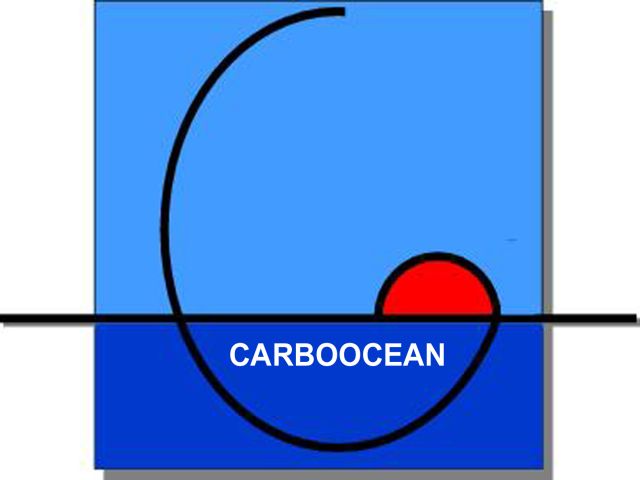Rationale
The best possible science-based projections of ocean carbon sink behaviour for scenarios of future
energy use and environmental change will be developed through an integrated modelling
framework. So far, the few available fully interactive carbon cycle climate model future scenarios
show a remarkable difference in the timing and magnitude between land-atmosphere, and airsea
fluxes. We therefore will consider as many as possible model systems in order to get a realistic
uncertainty estimate. The models to be used will be extended by new formulations for carbon
cycle feedback processes. It is expected, that the models will better reproduce reactions in the
marine carbon cycle in response to a change in forcing. The improvement of this model sensitivity
will lead to more realistic future projections.
Observations provide the ultimate foundation for any kind of ocean model which aims at
reproducing and understanding observed distributions of carbon cycle variables such as pCO2,
total inorganic CO2, and alkalinity. However, observations per se cannot predict what is likely to
happen in the future: Prognostic models are needed for this task, in particular as there are no real
geological analogs available for a climate under quick rise in atmospheric CO2 available (i.e. for
a strong radiative forcing in parallel to bi-polar ice sheets).
Worldwide, there exist only few prognostic three-dimensional biogeochemical ocean
general circulation models BOGCMs), which can be run in stand-alone mode (with appropriate
surface forcing) or interactively coupled to a full physical-dynamical Atmosphere Ocean General
Circulation Model (AOGCM). So far, only two studies with AOGCMs coupled to ocean as well
as terrestrial carbon cycle models were carried out. These studies revealed a remarkable difference
in the relative splitting between the overall sink for anthropogenic carbon over land and
over the oceans. Meanwhile, the development of ocean carbon cycle models has been made progress
through data assimilation (EU FP5 project NOCES) and implementation of particle dynamics.
In CARBOOCEAN we will use extended versions of the models used before, but add further
model systems which have not yet been applied in completely coupled modes. A novelty will be
the use of an isopycnal biogeochemical ocean model, which complements the dynamical ocean
models based on geometric levels. The vertical density resolution in this isopycnal BOGCM will
be large enough to also resolve deep water production processes in high latitude areas. The spectrum
of model approaches will yield a bandwidth of results, which serves as one basis for a subsequent
uncertainty assessment.
We will use a realistic anthropogenic CO2 emission scenario as forcing for the coupled
carbon cycle climate simulations. As also for the next assessment report of the IPCC (AR 4), interactive
climate carbon cycle runs are planned it is one option to also use a respective standard
IPPC emission scenario (e.g., scenario A1B). However, we will re-examine this scenario as it
provides a relative modest CO2 increase. We aim at seeing clear signals in our future scenarios
and may use a relatively pessimistic world view on human behaviour in future.
The models will be compared thoroughly with the observational data sets collated
within CARBOOCEAN and optimised as far as possible within the given time frame of the project.
This ensures that the initial conditions for the future scenarios are close to the present status
physical-biogeochemical ocean status in the real world. Thus theme5 has a very strong link to
themes 1 and 2. Core theme 3 will contribute to realistic boundary conditions for the future scenarios.
Present ocean models are primarily calibrated to data sets from the last 30 years. How
will the models react to the expected large change in forcing as a consequence of the anthropogenic
CO2 emissions ? We will implement the feedback processes as investigated in core theme
3 in order to achieve a correct sensitivity of the physical-biogeochemical modelling system with
respect to changes in external forcing.
The uncertainties of the future scenarios will be analysed in a dedicated project activity
at a later stage in the project after a first set of future simulations will have been completed.
As purposeful storage of CO2 in the ocean is a mitigation strategy, which is discussed at
present, also CARBOOCEAN will build up expertise on this topic. We will not address the full
spectrum of potential purposeful CO2 storage options, but rather concentrate on the so far most
realistic option via direct injection of CO2 into the deep sea and its implications for future oceanic
carbon source and sink distributions.
Objectives
O5.1 Fully coupled climate/ocean carbon cycle simulations using realistic scenarios for future
anthropogenic CO2 emissions including the biogeochemical feedbacks as investigated under core
theme 4 will provide transient CO2 source-sink distributions.
O5.2 A study on purposeful carbon dioxide storage will provide an estimate of the effectiveness,
and will build up expertise on the methodology and effectiveness of this mitigation option.
O5.3 The resulting changes in oceanic carbon source-sink behaviour over time and space will be
analysed in order to identify cause-effect relationships.
O5.4 The uncertainties of simulations on future ocean carbon sources and sinks will be quantitatively
determined.

